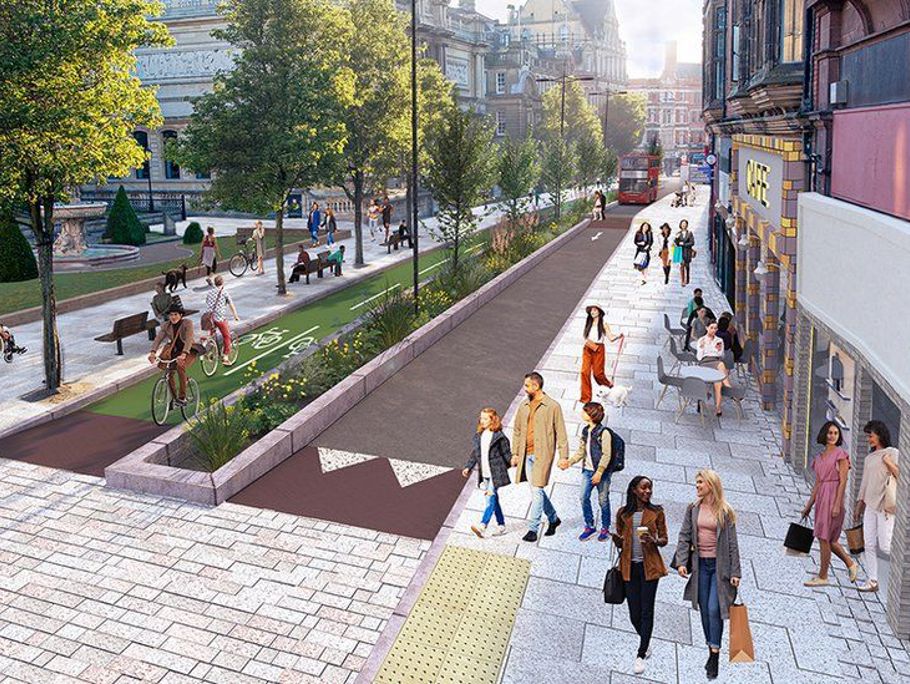Wolverhampton City Council’s vision of creating a thriving, vibrant city centre underpinned by Amey’s design and project management expertise delivered an aesthetically pleasing, sustainable design that made best use of existing environmental and historical assets while minimising both short and long-term costs.
The challenge
Wolverhampton’s City Centre Public Realm is a transformational, three-stage project that aims to create a thriving and vibrant heart for the city, supporting existing businesses and attracting new investment while also creating an environment to support a diverse events programme.
Creating a space that is attractive to pedestrians and cyclists and promotes public health and wellbeing was a key design consideration. Reducing and removing city centre traffic was therefore critical and the project combined full pedestrianisation of central spaces with a reconfiguration of surrounding streets to reduce traffic flow and promote the cycling and walking. The development also aims create a better, more inviting space to access the city’s nightlife venues. These elements sit alongside a vision for Connected Places and an ‘Events City’.
Amey was selected to produce the preliminary and detailed design for key elements of this flagship project, working in partnership with City of Wolverhampton City Council and landscape architect and principal contractor, Eurovia. Our scope of works included alignment design along with pavement, drainage, streetlighting and traffic signal design as well as street furniture.
Our approach
Commissioned to review the RIBA stage 3 preliminary design for stages one and three of the city centre redesign and then produce the detailed design and construction drawings while actively supporting the Early Contractor Involvement (ECI) process, Amey needed to integrate a comprehensive scope of works. This included reviewing existing drawings, progressing the detailed design phase including traffic signal changes and completing schedules associated with Traffic Regulation Orders (TROs).
Our review of the preliminary and landscape architect’s designs revealed significant issues and showed that this approach was neither practical nor feasible. This was because it did not allow access for large vehicles making deliveries to businesses within the city centre space.
Amey’s detailed design mitigated this issue and incorporated other changes and additional features requested by the Council. These included developing plans to integrate a semi-mature tree into the design and incorporating hostile vehicle mitigation. Flexible and client-centred, Amey produced a redesign to incorporate the tree – this included an elevated carriageway, porous paving and root protection - and worked with manufacturers and suppliers to identify the best approach to hostile vehicle mitigation while still maximising event space. Cost implications meant the tree elements of the redesign were not adopted.
Our approach included 3D modelling, reducing the risk of error during key elements of construction. Practicality and ease of maintenance was also a key consideration, reducing long term cost to the Council without forfeiting the aesthetics of the design. Amey actively managed the rerouting of traffic process, including TROs and schedules and ensured that speed and other assessments were undertaken to ensure hostile vehicle barriers were located for maximum benefit.
Benefits
Amey’s detailed design created a more attractive and accessible new city centre environment, encouraging pedestrian and cycle use and promoting health and wellbeing. This buildable and easily maintained design has now been taken through construction delivering significant environmental and cost benefits for the Council.
Early engagement with the principal contractor and ongoing dialogue with the Council and suppliers was critical to timely and cost-effective delivery of this transformational project. Use of 3D modelling – including surface modelling to maintain existing thresholds and using models to inform a cutting schedule for a granite supplier - reduced the risk of error and of longer term remedial and maintenance costs. Key features included maximising heritage and environmental assets, such as including a bespoke seating wall outside the city’s historic Civic Halls building.
